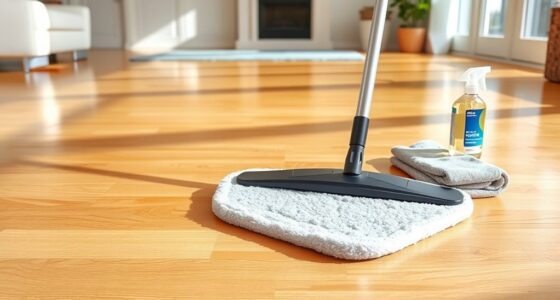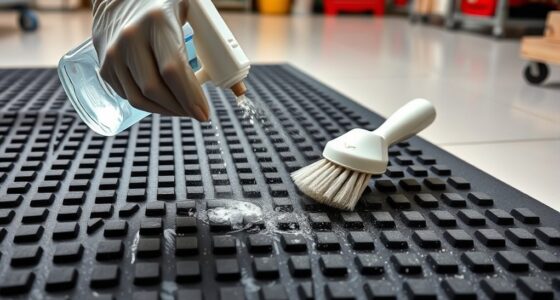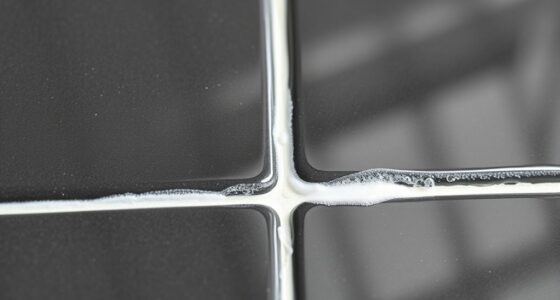To troubleshoot poor water pickup, start by inspecting and cleaning or replacing the filter to guarantee it isn’t clogged with debris or buildup, and check the housing for cracks. Next, examine the pump for damage, leaks, or unusual noises, and verify all connections are secure. Make sure there are no obstructions in hoses or fittings, and confirm the system has proper water levels and electrical supply. For more in-depth tips, keep exploring these troubleshooting steps.
Key Takeaways
- Inspect and clean or replace the filter to prevent debris buildup and ensure proper water flow.
- Check the pump for damage, leaks, or unusual noises, and verify it is functioning correctly.
- Ensure all hoses and fittings are secure, undamaged, and free of leaks or cracks.
- Confirm water levels are adequate and free from debris blocking the intake pathway.
- Examine the system for obstructions, buildup, or misalignment that could impede water pickup.

If your equipment isn’t picking up water properly, troubleshooting the issue quickly can save you time and prevent further damage. The first step is to check the filter. Over time, filters can become clogged with debris, dirt, or mineral buildup, restricting water flow. Remove the filter and inspect it closely. If it looks dirty or blocked, give it a thorough cleaning or replace it if necessary. Regular filter maintenance is vital for peak water pickup performance. A clean filter ensures that water flows freely into the system, preventing unnecessary strain on the pump and other components. Additionally, inspecting the filter housing for cracks or damage can help identify potential leaks that may impair water flow.
Regularly clean or replace your filter to ensure optimal water flow and prevent system strain.
Next, perform a pump inspection. A malfunctioning pump is often the root cause of poor water pickup. Start by examining the pump for any visible signs of damage, leaks, or corrosion. Listen for unusual noises when the pump is running, as these can indicate mechanical issues. Ensure that the pump’s inlet and outlet ports are clear of obstructions. Sometimes, debris or buildup can block these pathways, impeding water flow. If you notice any clogs or buildup, clear them out carefully. Check the pump’s impeller for damage or wear, as a damaged impeller can severely reduce water flow. If the pump looks worn or damaged, consider replacing it to restore proper function.
While inspecting the pump, also verify that the connections are secure and that there are no leaks or cracks in the hoses or fittings. Loose fittings can cause air leaks, which reduce the pump’s efficiency and hinder water pickup. Tighten any loose connections and replace damaged hoses or fittings as needed. Additionally, ensure that the pump’s power supply is consistent and that the motor is functioning correctly. Sometimes, electrical issues can cause the pump to underperform or fail altogether. Checking the system’s design and setup can also help identify issues caused by poor positioning or inadequate water levels, ensuring optimal performance.
Frequently Asked Questions
How Often Should I Check My Water Pickup System?
You should check your water pickup system at least monthly to ensure peak performance. Follow a maintenance schedule and use an inspection checklist to catch issues early. Regular inspections help identify clogs, leaks, or debris that could hinder water flow. Staying consistent with these checks prevents costly repairs and keeps your system running smoothly. Don’t skip your routine; timely maintenance is key to avoiding water pickup problems.
Can Water Quality Affect Pickup Performance?
Think of your water pickup system as a essential lifeline; when water contamination occurs, it’s like poison seeping into the flow, harming pump efficiency. Poor water quality directly impacts performance, causing clogs or reduced flow. To keep your system running smoothly, ensure water is clean and free from debris. Regular testing helps identify contamination early, safeguarding your pump’s efficiency and maintaining reliable water pickup whenever you need it most.
What Tools Are Needed for Water Pickup Troubleshooting?
You’ll need basic tools like a screwdriver, wrench, and a multimeter to check water flow and pump performance. A pressure gauge helps monitor system pressure, while inspecting the pump for debris or wear is essential. Regular pump maintenance, such as cleaning filters and verifying connections, guarantees peak water pickup. These tools and steps help you identify issues quickly, improving water flow and overall system efficiency.
How Do I Prevent Debris From Clogging the System?
To prevent debris from clogging your system, regularly perform filter maintenance and inspect filters for debris buildup. Use debris prevention techniques like installing a pre-filter or screen to catch larger particles before they reach the main system. Keep the filters clean and replace them as needed, especially after heavy use or if you notice a drop in water flow. Consistent maintenance helps make sure smooth water pickup and prevents costly clogs.
When Should I Replace My Water Pickup Components?
Think of your water pickup system as a diligent guardian of your water flow. You should replace your water filter and perform pump maintenance when you notice reduced water flow, strange noises, or increased strain on the system. Regularly inspecting these components guarantees they don’t become bottlenecks, much like pruning a tree keeps it healthy. Don’t wait for complete failure—timely replacement keeps your water pickup running smoothly and efficiently.
Conclusion
Now that you’ve navigated the tangled wires and clogs, remember that your water pickup system is like a delicate dance—each part must move in harmony. When issues strike, don’t let frustration drown you; instead, tune into the clues like a detective following a trail. With patience and a sharp eye, you’ll restore smooth flow like a gentle river, bringing your system back to life. Trust your skills—you hold the key to keeping everything running seamlessly.









